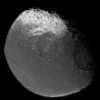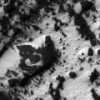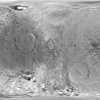Iapetus, Saturn's third largest moon, has an almost perfectly circular orbit with a radius of 3,560,820 km (2,212,600 miles), taking 79 days to complete one orbit and one revolution as it always has the same face to Saturn. The orbit is much more inclined than most of Saturn's moons, meaning there is a clear view of the rings from the moon's surface. It is roughly spherical, about 1,471 km (914 miles) across, and comprises mainly ice with only about 20% rock.
Cassini captured the upper image of Iapetus on December 31st, 2004 from about 172,400 kilometers (c. 107,000 miles) away. To the right is the dark, heavily-cratered region, called Cassini Regio. This cover almost half of the surface of Iapetus. This is not an impact crater, though its origin is not clearly understood. It could result from material that erupted onto the surface from the interior, or it could be material from the outer satellites, ejected by impacts, that then accumulated on the surface of Iapetus.
Another remarkable feature is a ridge along the equator that is seen clearly in the picture. The ridge is approximately 1,300 km (800 miles) long, 20 km (12 miles) wide, and reaches up to 13 km (8 miles) high. It is not yet clear whether the ridge is a compression feature, like a mountain belt that has folded upward, or an extended crack in the surface through which material from inside Iapetus erupted onto the surface forming the ridge. It gives Iapetus the look of a walnut! Just about in the center of the image is another large feature; a crater some 400 kilometer (250 miles) across, which is overlaid with many more recent impact craters. There are nine large impact basins about this ize on the surface of Iapetus.
Cassini took the lower image on the right in 2007 from a distance of 62,331km (c. 38,750 miles), and shows the ridge very clearly.
Cassini captured the upper image of Iapetus on December 31st, 2004 from about 172,400 kilometers (c. 107,000 miles) away. To the right is the dark, heavily-cratered region, called Cassini Regio. This cover almost half of the surface of Iapetus. This is not an impact crater, though its origin is not clearly understood. It could result from material that erupted onto the surface from the interior, or it could be material from the outer satellites, ejected by impacts, that then accumulated on the surface of Iapetus.
Another remarkable feature is a ridge along the equator that is seen clearly in the picture. The ridge is approximately 1,300 km (800 miles) long, 20 km (12 miles) wide, and reaches up to 13 km (8 miles) high. It is not yet clear whether the ridge is a compression feature, like a mountain belt that has folded upward, or an extended crack in the surface through which material from inside Iapetus erupted onto the surface forming the ridge. It gives Iapetus the look of a walnut! Just about in the center of the image is another large feature; a crater some 400 kilometer (250 miles) across, which is overlaid with many more recent impact craters. There are nine large impact basins about this ize on the surface of Iapetus.
Cassini took the lower image on the right in 2007 from a distance of 62,331km (c. 38,750 miles), and shows the ridge very clearly.
Iapetus
Solar System -
Saturn's Moons
This image shows part of Iapetus in the transition region between the moon’s dark leading hemisphere, and its bright trailing hemisphere. Cassini took the picture during its close flyby of the moon in 2007 from a distance of 5,260 kilometers (3,270 miles).
This image is a false-color mosaic showing the trailing hemisphere of Iapetus. Towards the bottom of he image there is a very large crater, some 450-kilometer (280-mile) in diameter. Look closely, and you will see that it overlaps an older, similar-sized crater at its bottom right. The mage was taken from about 73,000 km (45,000 miles) from Iapetus.
This shows a large number of craters in the dark terrain of Iapetus' leading hemisphere. The rising terrain towards the bottom of the image is part of the equatorial ridge. The fact that there are so many craters on top of the ridge, and their apparent age, indicates that the ridge is an ancient feature. The mage was taken from about 63,000 kilometers (39,000 miles) from Iapetus.
An equidistant projection map of Iapetus based on images taken by Cassini. Click here if you wish to see the full sized image on the NASA website.
Saturn's moons are grouped as follows. Select to see details of the moon or the group of moons:
Mimas • Enceladus • Tethys • Dione • Rhea • Titan • Iapetus • Hyperion • Norse Grp • Shepherd Moons • Alkyonides • Inuit Grp • Gallic Grp • Misc







